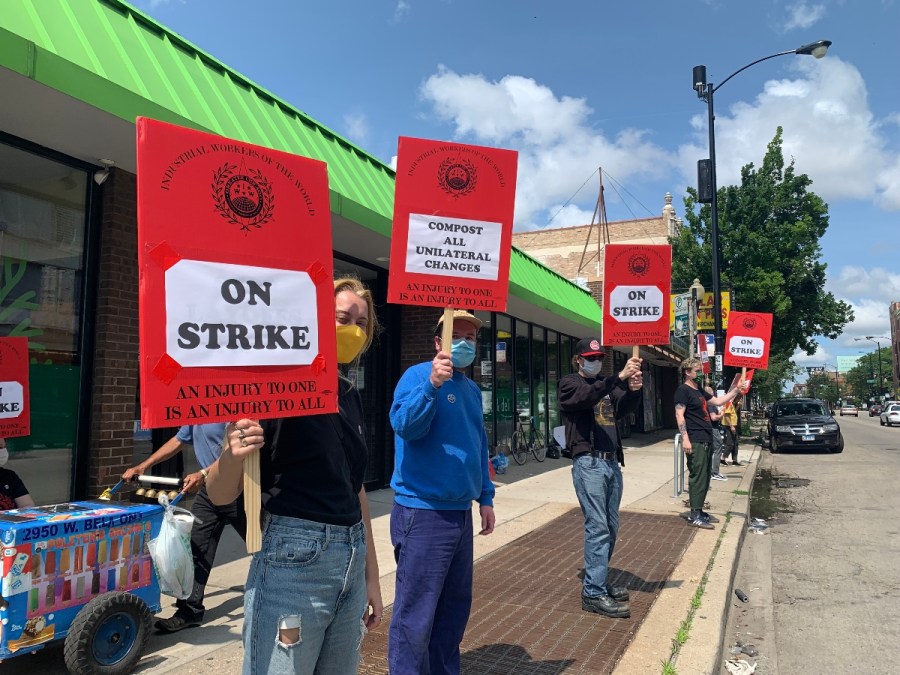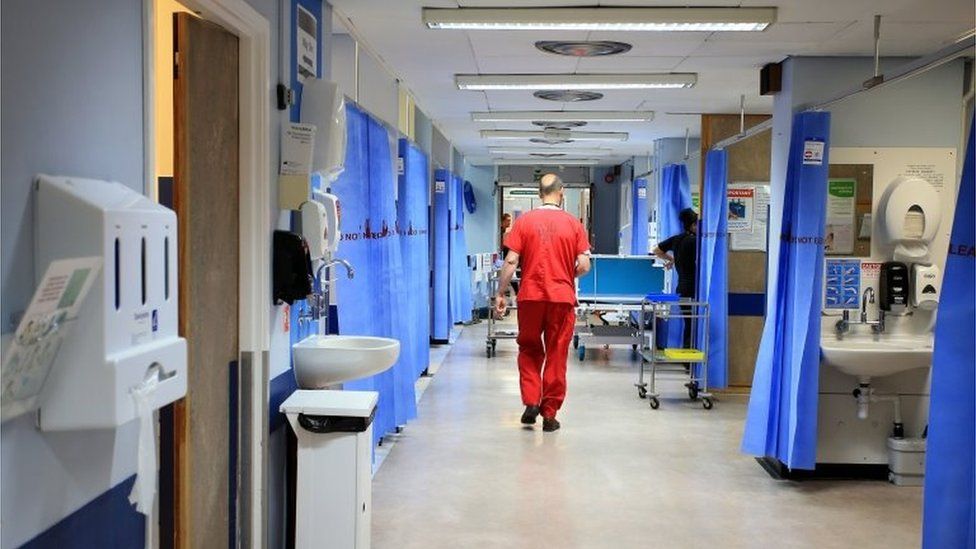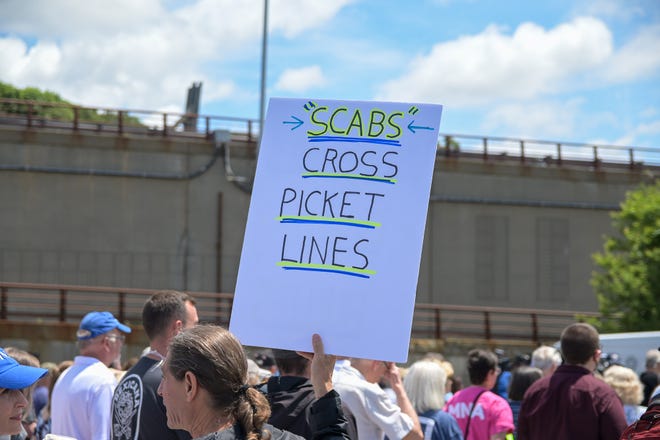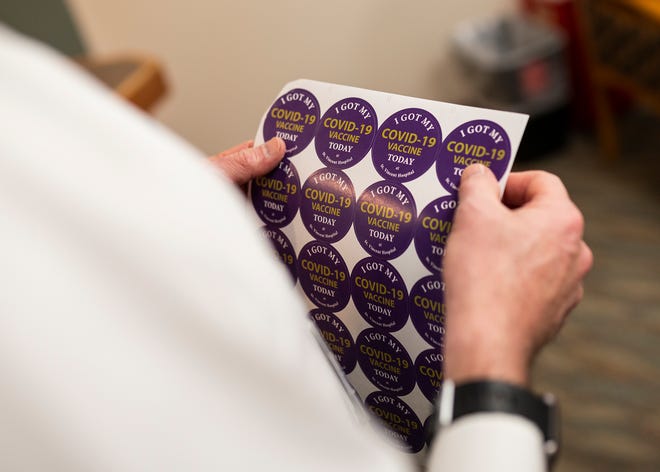Robots were supposed to take our jobs. Instead, they’re making them worse.
The robot apocalypse is already here, it just looks different than you thought.
By Emily Stewartemily.stewart@vox.com Jul 2, 2021
The robot revolution is always allegedly just around the corner. In the utopian vision, technology emancipates human labor from repetitive, mundane tasks, freeing us to be more productive and take on more fulfilling work. In the dystopian vision, robots come for everyone’s jobs, put millions and millions of people out of work, and throw the economy into chaos.
Such a warning was at the crux of Andrew Yang’s ill-fated presidential campaign, helping propel his case for universal basic income that he argued would become necessary when automation left so many workers out. It’s the argument many corporate executives make whenever there’s a suggestion they might have to raise wages: $15 an hour will just mean machines taking your order at McDonald’s instead of people, they say. It’s an effective scare tactic for some workers.
But we often spend so much time talking about the potential for robots to take our jobs that we fail to look at how they are already changing them — sometimes for the better, but sometimes not. New technologies can give corporations tools for monitoring, managing, and motivating their workforces, sometimes in ways that are harmful. The technology itself might not be innately nefarious, but it makes it easier for companies to maintain tight control on workers and squeeze and exploit them to maximize profits.
“The basic incentives of the system have always been there: employers wanting to maximize the value they get out of their workers while minimizing the cost of labor, the incentive to want to control and monitor and surveil their workers,” said Brian Chen, staff attorney at the National Employment Law Project (NELP). “And if technology allows them to do that more cheaply or more efficiently, well then of course they’re going to use technology to do that.”
Tracking software for remote workers, which saw a bump in sales at the start of the pandemic, can follow every second of a person’s workday in front of the computer. Delivery companies can use motion sensors to track their drivers’ every move, measure extra seconds, and ding drivers for falling short.
Automation hasn’t replaced all the workers in warehouses, but it has made work more intense, even dangerous, and changed how tightly workers are managed. Gig workers can find themselves at the whims of an app’s black-box algorithm that lets workers flood the app to compete with each other at a frantic pace for pay so low that how lucrative any given trip or job is can depend on the tip, leaving workers reliant on the generosity of an anonymous stranger. Worse, gig work means they’re doing their jobs without many typical labor protections.
In these circumstances, the robots aren’t taking jobs, they’re making jobs worse. Companies are automating away autonomy and putting profit-maximizing strategies on digital overdrive, turning work into a space with fewer carrots and more sticks.
A robot boss can do a whole lot more watching
In recent years, Amazon has become the corporate poster child for automation in the name of efficiency — often at the expense of workers. There have been countless reports of unsustainable conditions and expectations at Amazon’s fulfillment centers. Its drivers reportedly have to consent to being watched by artificial intelligence, and warehouse workers who don’t move fast enough can be fired.
Demands are so high that there have been reports of people urinating in bottles to avoid taking a break. The robots aren’t just watching, they’re also picking up some of the work. Sometimes, it’s for the better, but in other cases, they may actually be making work more dangerous as more automation leads to more pressure on workers. One report found that worker injuries were more prevalent in Amazon warehouses with robots than warehouses without them.
Amazon is hardly the only company that uses automation to keep tabs on workers and push them to do more. In 2020, Josh Dzieza at the Verge outlined the various ways artificial intelligence, software, and machines are managing workers at places such as call centers, warehouses, and software development shops. He described one remote engineer in Bangladesh who was monitored by a program that took three pictures of him every 10 minutes to make sure he was at his computer, and a call center worker who learned to say “sorry” a lot to customers in order to meet an artificial intelligence-based empathy monitor. A web of technologies has enabled the management of every minute of the working day.
“It would have been prohibitively expensive to employ enough managers to time each worker’s every move to a fraction of a second or ride along in every truck, but now it takes maybe one,” Dzieza wrote. “This is why the companies that most aggressively pursue these tactics all take on a similar form: a large pool of poorly paid, easily replaced, often part-time or contract workers at the bottom; a small group of highly paid workers who design the software that manages them at the top.”
A 2018 Gartner survey found that half of large companies were already using some type of nontraditional techniques to keep an eye on their workers, including analyzing their communications, gathering biometric data, and examining how workers are using their workspace. They anticipated that by 2020, 80 percent of large companies would be using such methods. Amid the pandemic, the trend picked up pace as businesses sought more ways to keep tabs on the new waves of workers working from home.
This has all sorts of implications for workers, who lose privacy and autonomy when they’re constantly being watched and directed by technology. Daron Acemoglu, an economist at MIT, warned that they’re also losing money. “Some of these new digital technologies are not simply replacing workers or creating new tasks or changing other aspects of productivity, but they’re actually monitoring people much more effectively, and that means rents are being shared very differently because of digital technologies,” he said.
He offered up a hypothetical example of a delivery driver who is asked to deliver a certain number of packages in a day. Decades ago, the company might pay the driver more to incentivize them to work a little faster or harder or put in some extra time. But now, they’re constantly being monitored so that the company knows exactly what they’re doing and is looking for ways to save time. Instead of getting a bonus for hitting certain metrics, they’re dinged for spending a few seconds too long here or there.
The problem isn’t technology itself, it’s the managers and corporate structures behind it that look at workers as a cost to be cut instead of as a resource.
“A lot of this boom of Silicon Valley entrepreneurship where venture capital made it very easy for companies to create firms didn’t exactly prioritize the well-being of workers as one of their main considerations,” said Amy Bix, a historian at Iowa State University who focuses on technology. “A lot of what goes on in the structure of these corporations and the development of technology is invisible to most ordinary people, and it’s easy to take advantage of that.”
The future of Uber isn’t driverless cars, it’s drivers
Uber’s destiny was supposed to be driverless.
In 2016, former CEO Travis Kalanick told Bloomberg making an autonomous vehicle was “basically existential” for the company. After a deadly accident with an autonomous Uber vehicle in 2018, current chief executive Dara Khosrowshahi reiterated that the company remained “absolutely committed” to the self-driving cause. But in December 2020 and after investing $1 billion, Uber sold off its self-driving unit. A little over four months later, its main competitor, Lyft, followed suit. Uber says it’s still not giving up on autonomous technology, but the writing on the wall is clear that driverless cars aren’t core to Uber’s business model, at least in the near future.
“Five or 10 years from now, drivers are still going to be a big piece of the mix on a percentage basis [of Uber’s business], and on an absolute basis, they may be an even bigger piece than they are today even with autonomous in the mix because the business should get bigger as both segments get bigger,” said Chris Frank, director of corporate ratings at S&P Global. “In addition, drivers will need to handle more complex conditions like poorly marked roads or inclement weather.”
In other words, they’re going to need workers to make money — workers they would very much like not to classify as such.
Gig economy companies such as Uber, Lyft, and DoorDash are fighting tooth and nail to make sure the people they enlist to make deliveries or drive people around are not considered their employees. In California last year, such companies dumped $200 million into lobbying to pass Proposition 22, which lets app-based transportation and delivery companies classify their workers as independent contractors and therefore avoid paying for benefits such as sick leave, employer-provided health care, and unemployment. After it passed, a spokesman for the campaign for the ballot measure said it “represents the future of work in an increasingly technologically-driven economy.”
It’s a future of work that might not be pleasant for gig workers. In California, some workers say they’re not getting the benefits companies promised after Prop 22’s passage, such as health care stipends. Companies said that workers would make at least 120 percent of California’s minimum wage, but that’s contemplating the time they spend driving only. Before the ballot initiative was passed, research from the UC Berkeley Labor Center estimated that it would guarantee a minimum wage of just $5.64 per hour.
Companies say they’ve been clear with drivers about how to qualify for the health care stipend, which is available to drivers with more than 15 engaged hours a week (in other words, if you don’t have a job and are waiting around, it doesn’t count). In a statement to Vox, Geoff Vetter, a spokesperson for the Protect App-Based Drivers + Services Coalition, the lobbying group that championed Prop 22, said that 80 percent of drivers work fewer than 20 hours per week and most work less than 10 hours per week, and that many have health insurance through other jobs.
Gig companies have sometimes been cagey about how much their workers make, and they’re often changing their formulas. In 2017, Uber agreed to pay the Federal Trade Commission $20 million over charges that it misled prospective drivers about how much they could make with the app. The FTC found that Uber claimed some of its drivers made $90,000 in New York and $74,000 in San Francisco, when in reality their median incomes were actually $61,000 and $53,000, respectively. DoorDash caused controversy over a decision to pocket tips and use them to pay delivery workers, which it has since reversed.
Even though Uber is charging customers more for rides in the wake of the pandemic, that’s not directly being passed onto their drivers. According to the Washington Post, Uber changed the way it paid drivers in California soon after Prop 22 passed so that they were no longer paid a proportion of the cost of the ride but instead by time and distance, with different bonuses and incentives based on market and surge pricing. (This is how Uber does it in most states, but it had changed things up during the push to get Prop 22 passed.) Uber’s CEO pushed back on the Post story in a series of tweets, arguing that decoupling driver pay from customer fares had not hurt California drivers and that some are now getting a higher cut from their rides.
In light of a driver shortage, Uber recently announced what it’s billing as a $250 million “driver stimulus” that promises higher earnings to try to get drivers back onto the road. The company acknowledges this initiative is likely temporary once the supply-demand imbalance works itself out. Still, it’s hard not to notice how quickly Uber and Lyft have been able to corner most of the ride-hailing app market and exert control over their drivers and customers.
“When a new thing like this comes on, there’s huge new consumer benefits, and then over time they are the market, they have less competition except one another, probably they’re a cartel at this point. And then they start doing stuff that’s much nastier,” said David Autor, an economist at MIT.
One of the gig economy’s main selling points to workers is that it offers flexibility and the ability to work when they want. It’s certainly true that an Uber or Lyft driver has much more autonomy on the job than, say, an Amazon warehouse worker. “People drive with Lyft because they prefer the freedom and flexibility to work when, where, and for however long they want,” a Lyft spokesperson said in a statement to Vox. “They can choose to accept a ride or not, enjoy unlimited upward earning potential, and can decide to take time off from driving whenever they want, for however long they want, without needing to ask a ‘boss’ — all things they can’t do at most traditional jobs.” The spokesperson also noted that most of its drivers work outside of Lyft.
But flexibility doesn’t mean gig companies have no control over their drivers and delivery people. They use all sorts of tricks and incentives to try to push workers in certain directions and manage them, essentially, by algorithm. Uber drivers report being bothered by the constant surveillance, the lack of transparency from the company, and the dehumanization of working with the app. The algorithm doesn’t want to know how your day is, it just wants you to work as efficiently as possible to maximize its profits.
Carlos Ramos, a former Lyft driver in San Diego, described the feeling of being manipulated by the app. He noticed the company must have needed morning drivers because of the incentives structures, but he also often wondered if he was being “punished” if he didn’t do something right.
“Sometimes, if you cancel a bunch of rides in a row or if you don’t take certain rides to certain things, you won’t get any rides. They’ve shadow turned you off,” he said. The secret deprioritization of a worker is something many Lyft and Uber drivers speculate happens. “You also have no way of knowing what’s going on behind there. They have this proprietary knowledge, they have this black box of trade secrets, and those are your secrets you’re telling them,” said Ramos, now an organizer with Gig Workers Rising.
Companies deny that they secretly shut off drivers. “It is in Lyft’s best interests for drivers to have as positive an experience as possible, so we communicate often and work directly with drivers to help them improve their earnings,” a Lyft spokesperson said. “We never ‘shadow ban’ drivers, and actively coach them when they are in danger of being deactivated.”
The future of innovation isn’t inevitable
We often talk about technology and innovation with a language of inevitability. It’s as though whenever wages go up, companies will of course replace workers with robots. Now that the country is turned on to online delivery, it can be made to seem like the grocery industry is on an unavoidable path to gig work. After all, that’s what happened with Albertsons. But that’s not really the case — there’s plenty of human agency in the technological innovation story.
“Technology of course doesn’t have to exploit workers, it doesn’t have to mean robots are coming for all of our jobs,” Chen said. “These are not inevitable outcomes, they are human decisions, and they are almost always made by people who are driven by a profit motive that tends to exploit the poor and working class historically.”
Chase Copridge, a longtime California worker who’s done the gamut of gig jobs — Instacart, DoorDash, Amazon Flex, Uber, and Lyft — is one of the people stuck in that position, the victim of corporate tendencies on technological overdrive. He described seeing delivery offers that pay as little as $2. He turns those jobs down, knowing that it’s not economically worth it for him. But there might be someone else out there who picks it up. “We’re people who desperately need to make ends meet, who are willing to take the bare minimum that these companies are giving out to us,” he said. “People need to understand that these companies thrive off of exploitation.”
Not all decisions around automation are ones that increase productivity or improve really anything except corporate profits. Self-checkout stations may reduce the need for cashiers, but are they really making the shopping experience faster or better? Next time you go to the grocery store and inevitably screw up scanning one of your own items and waiting several minutes for a worker to appear, you tell me.
Despite technological advancements, productivity growth has been on the decline in recent years. “This is the paradox of the last several decades, and especially since 2000, that we had enormous technological changes as we perceive it but measured productivity growth is quite weak,” Autor said. “One reason may be that we’re automating a lot of trivial stuff rather than important stuff. If you compare antibiotics and indoor plumbing and electrification and air travel and telecommunications to DoorDash and smartphones or self-checkout, it may just not be as consequential.
Acemoglu said that when firms focus so much on automation and monitoring technologies, they might not explore other areas that could be more productive, such as creating new tasks or building out new industries. “Those are the things that I worry have fallen by the wayside in the last several years,” he said. “If your employer is really set on monitoring you really tightly, that biases things against new tasks because those are things that are not easier to monitor.”
It matters what you automate, and not all automation is equally beneficial, not only to workers but also to customers, companies, and the broader economy.
Grappling with how to handle technological advancements and the ways they change people’s lives, including at work, is no easy task. While the robot revolution isn’t taking everyone’s jobs, automation is taking some of them, especially in areas such as manufacturing. And it’s just making work different: A machine may not eliminate a position entirely, but it may turn a more middle-skill job into a low-skill job, bringing lower pay with it. Package delivery jobs used to come with a union, benefits, and stable pay; with the rise of the gig economy, that’s declining. If and when self-driving trucks arrive, there will still be some low-quality jobs needed to complete tasks the robots can’t.
“The issue that we’ve faced in the US economy is that we’ve lost a lot of middle-skill jobs so people are being pushed down into lower categories,” Autor said. “Automation historically has tended to take the most dirty and dangerous and demeaning jobs and hand them over to machines, and that’s been great. What’s happened in the last bunch of decades is that automation has affected the middle-skill jobs and left the hard, interesting, creative jobs and the hands-on jobs that require a lot of dexterity and flexibility but don’t require a lot of formal skills.”
But again, none of this is inevitable. Companies are able to leverage technology to get the most out of workers because workers often don’t have power to push back, enforce limits, or ask for more. Unionization has seen steep declines in recent decades. America’s labor laws and regulations are designed around full-time work, meaning gig companies don’t have to offer health insurance or help fund unemployment. But the laws could — and many would argue should — be modernized.
“The key thing is it’s not just technology, it’s a question of labor power, both collectively and individually,” Bix said. “There are a lot of possible outcomes, and in the end, technology is a human creation. It’s a product of social priorities and what gets developed and adopted.”
Maybe the robot apocalypse isn’t here yet. Or it is, and many of us aren’t quite recognizing it, in part because we got some of the story wrong. The problem isn’t really the robot, it’s what your boss wants the robot to do.
/cdn.vox-cdn.com/uploads/chorus_image/image/69533731/972039208.0.jpg)
/cdn.vox-cdn.com/uploads/chorus_image/image/69494869/646455098.0.jpg)

/https://www.therecord.com/content/dam/therecord/news/waterloo-region/2021/06/30/waterloo-region-workers-take-step-closer-to-strike/kwr061512_regional_hq.jpg)












